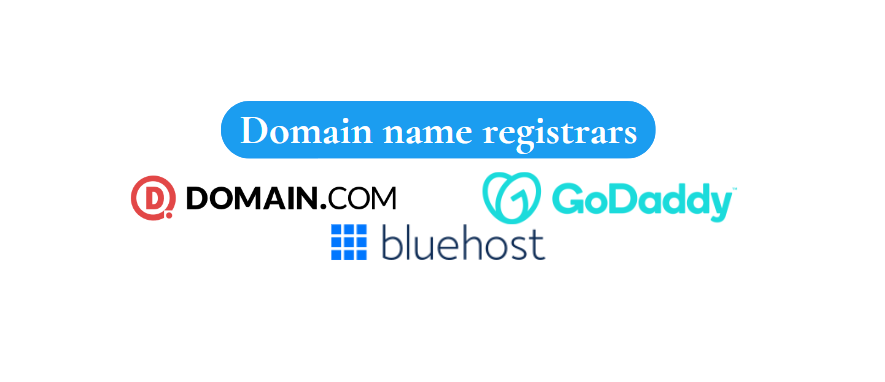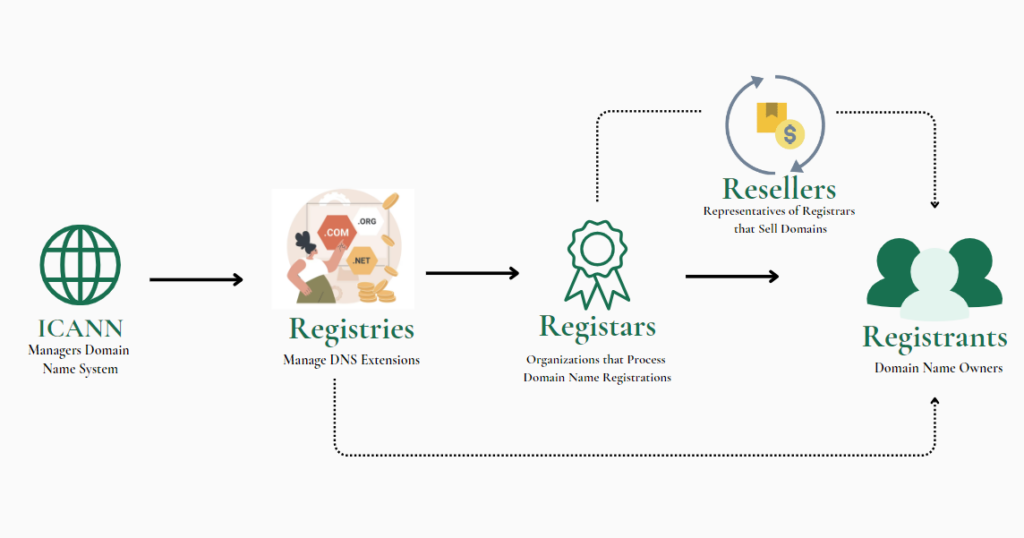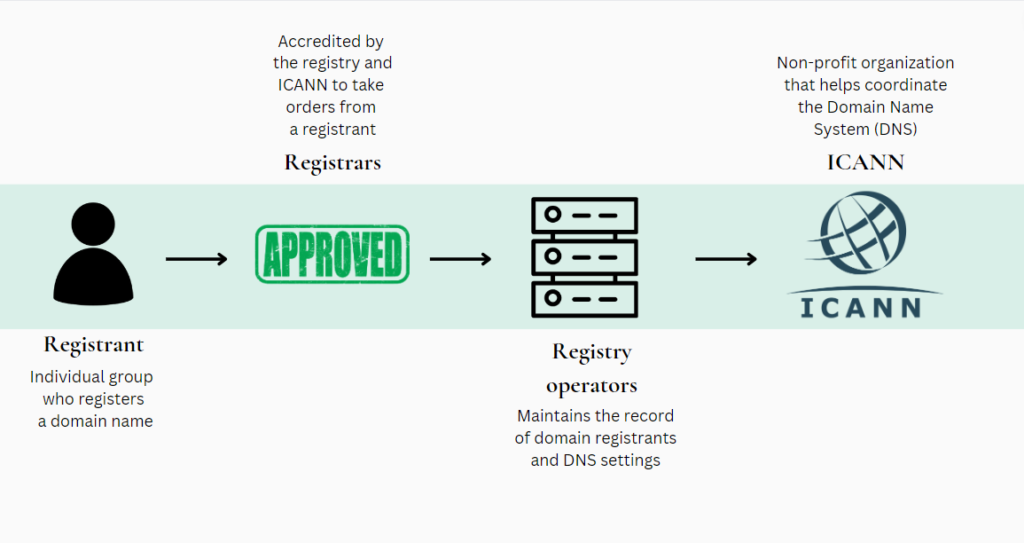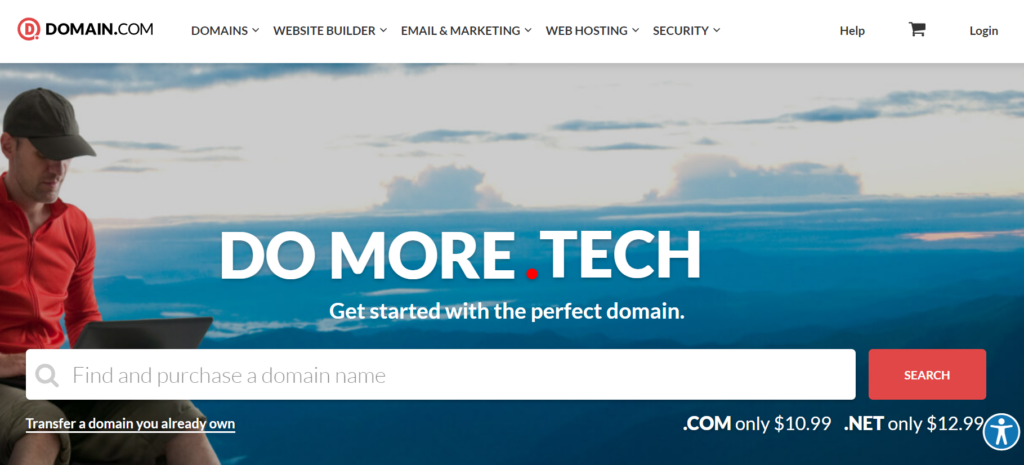What is a Domain Registrar? Choose the Best Registar in 2023
- What is a domain registrar?
- How domain registrars work
- 2 types of domain registrars to go for
- How to register a domain
- How to find the best registrar
- How to become a domain name registrar
- Conclusion
Want to know what is a domain registrar? Let’s break it down in simple terms.
A domain registrar is like your personal assistant when it comes to buying and managing your own website address.
Imagine a domain name as the unique address that a website has on the Internet. Just like ours is trustindex.io.
If you’re planning to create a website, having a domain name is needed.
And that’s where a domain registrar comes into play. They are the ones who help you acquire and take care of your chosen domain name.
In essence, a domain registrar simplifies the process of purchasing and maintaining your website address.
This guide aims to shed light on what exactly a domain registrar does, how they handle domain registration, and how they differ from other elements like domain registries, domain name hosts, and the DNS system.
Feeling a bit confused? Don’t worry! We’ll delve deeper into these topics to make it clearer for you.
What is a Domain Name Registrar?
As mentioned earlier, buying and registering your domain name is essential.
And the place to do this is with a domain name registrar.
So to answer your question what is a domain registrar: it is an individual or company that assists you in buying and registering domain names.
Fortunately, domain registrars provide user-friendly tools that help you search for available domain names.
All you have to do is enter your desired name and complete the payment process.
It’s important to note that they don’t sell domain names to you outright.
Instead, you lease them for a specific period of time. Most domain registrars keep track of the expiration dates and even offer renewal services.

How Do Domain Registrars Work?

You can’t simply buy a domain name off the shelf like a regular product.
The process involves following a systematic protocol that is overseen by a nonprofit organization called ICANN (Internet Corporation for Assigned Names).
ICANN is responsible for managing domain name registration. To make a domain name valid, it needs to be entered into ICANN’s central registry, known as the domain registry.
The domain registry’s role is to manage and maintain domain names.
Selling domain names, on the other hand, is the task of domain registrars.
To become a domain name registrar, you need to be an ICANN accredited registrar. Once accredited, registrars can sell domain names directly to the public or through resellers.
A word of advice: if you want reliable services, it’s generally better to purchase your domain names directly from the domain registrars rather than resellers.
When choosing a registrar, it’s important to note that not all registrars offer a wide range of domain extensions.
Domain extensions refer to the suffixes that come after the domain name, such as .com, .edu, .org, and country-specific extensions like .en, .in, and .au.
For instance, Verisign manages the domain registry for .com domain names.
If you want a .com domain for your website, you’ll need to buy it from a registrar that deals with .com extensions.
The domain registrar will inform Verisign to reserve the domain for you and will handle the payment for the domain name registrations to Verisign on your behalf.
The domain registrar includes this fee in the amount they charge you.
Role of IANA in Internet Infrastructure
Another organization to mention is IANA (Internet Assigned Numbers Authority)
IANA oversees the allocation and distribution of IP addresses to Regional Internet Registries (RIRs) that further assign them to internet service providers and organizations.
It also manages the root zone of the DNS, which includes the administration of top-level domains (TLDs) like .com, .org, and country-code TLDs like .uk, .de, etc.
Additionally, IANA is responsible for maintaining protocol registries, ensuring unique values are assigned to various internet protocols and standards.
Hybrid or One-Stop Shop Domain Registration?
In recent times, many companies have adopted a hybrid approach, offering a range of services including domain registration, hosting, privacy administration, and domain transfers.
This convenient setup allows you to handle all your website-related needs in one place, eliminating the hassle of dealing with multiple providers.
If possible, we highly recommend choosing a company that follows this comprehensive “one-stop shop” business model, rather than one that solely focuses on domain name registration.
Ideally, opt for a company that serves as both a domain registrar and a hosting provider.
By doing so, you can avoid the inconvenience and potential extra costs of transferring your domain to a separate web hosting company.

What is the role of a Domain Name Server (DNS)?
Earlier, we discussed how computers use IP addresses rather than domain names to locate websites.
Domain name servers bridge the gap between the two. The Domain Name System (DNS) is the protocol that ensures accurate data exchange, allowing internet users to view the correct websites when they enter a domain name or click on a link.
Domain name servers are integral to this system as they store the necessary information to link a specific domain name to its corresponding IP address.

Whenever a computer requests a domain name, it queries a domain name server to obtain the correct IP address.
This ensures that the desired webpage is served up correctly.
How to Register a New Domain?
Now that we’ve covered a lot of the technical aspects, you’re probably wondering how all of this translates into what you, as a website owner, need to do to get the domain name you want for your site.
The good news is that the process is relatively simple for you.
Let’s walk through it step by step.
1.) First, you need to find a domain registrar you want to work with.
Later on, we’ll discuss how to do that in more detail.
Most domain registrars make it easy for you to search for available domain names.
They provide options for different top-level domains (TLDs) that you can consider, such as .com, .org, or others.
2.) Once you’ve found the perfect domain name, you can proceed with the purchasing process.
During the purchase, the registrar’s website will typically provide a secure form where you can enter your name, contact information, and payment details.
Fill out the form with the required information, ensuring that you’re providing accurate and up-to-date details.
3.) After completing the secure form, you should be all set! The domain registrar will process your payment and finalize the registration of your chosen domain name.
How to Find the Best Domain Registrar?
✔️ What to look for in a good domain registrar:
Price
Creating a website involves various costs, including domain fees.
Good registrars often offer tiered pricing models with a reasonable starting price. Beware of significantly overpriced domain fees.
On average, domain registration costs range from $15 to $24 for .org and .com domains.
Free WHOIS Protection
To protect the privacy of domain registrants, a reputable registrar should offer free WHOIS protection.
This service replaces your contact data with registrar data in the public WHOIS database.
Flexible Registration Period
Registrars should provide flexible registration periods, allowing users to choose the duration that suits their needs.
Options should include a few months, a year, or several years, so you don’t have to register a domain for longer or shorter than necessary.
Automated Renewals/Reminders
For domains registered for multiple years, registrars should offer automated renewals.
Additionally, reminders about contract renewals can help users cancel if they no longer wish to continue.
Large Selection of TLDs
Look for a registrar that offers a wide selection of top-level domain (TLD) endings.
While .org and .com are standard, having other options like .info or .net expands your choices.
Restricted Domains
Some domains, like .biz for “business,” are restricted and have specific registration conditions.
If needed, choose a registrar that also provides these restricted domains.
Other Products and Services
Consider registrars that offer all-in-one domain name registration services or combination packages.
These may include hosting, SSL encryption, website creation, or the ability to register multiple domains in addition to domain registration.
❌ Avoid the domain registrar with these qualities:
Non-Transparent Pricing
Be cautious of providers with unclear or ambiguous pricing presented on their websites.
Carefully read the fine print to avoid any unexpected disadvantages.
Poor Customer Service
A good domain name registrar should prioritize customer support.
If there is no indication of customer service on their website or if support is lacking, consider choosing a different registrar.
Cluttered User Interface
A complicated and confusing user interface does not inspire confidence and may reflect the registrar’s overall quality.
Not all domain registrars have intuitive, appealing, and self-explanatory user interfaces.
Unwanted Add-ons
Questionable registrars may automatically add additional services, such as hosting, when you sign a contract, increasing the overall price.
Before signing, ensure that all included services are clearly listed and avoid surprises.
How to Become a Domain Registrar?
To become a domain name registrar, you need to follow the accreditation process set by ICANN.
- Complete and Submit Accreditation Form: Start by filling out and submitting ICANN’s accreditation form. This form requires you to provide relevant information about your business.
- Verification of Information: ICANN will verify the information you provided, including details about your finances and your IT infrastructure, scalability, and DNS configuration.
- Sign and Submit Registrar Accreditation Agreement (RAA): Once your information is verified, you need to sign and submit the Registrar Accreditation Agreement (RAA). This agreement outlines the terms and conditions for your accreditation as a domain registrar.
- Sign and Submit Registrar Data Escrow (RDE) Agreement: Along with the RAA, you also need to sign and submit the Registrar Data Escrow (RDE) Agreement. This agreement ensures that you securely store and regularly submit registrant data to an ICANN-approved Registrar Data Escrow Agent.
- Pay Accreditation Fee: As part of the process, you are required to pay the accreditation fee set by ICANN.
- Confirmation of Accreditation: After completing all the necessary steps and fulfilling the requirements, you will receive confirmation of your accreditation from ICANN. This means you are officially listed as an accredited domain registrar.
Once accredited, you can start selling domain names to registrants through the appropriate domain registry.
It’s important to comply with ICANN (Internet Corporation for Assigned Names) policies and regulations to maintain your accreditation status and provide reliable domain registration services.
Keep in mind: To become a domain name registrar, you must pay a non-refundable application fee of $3,500, followed by an annual accreditation fee of $4,000.
Find Your Domain Name Registrar Today
If you’re ready to get started with a domain name and domain registrar, we’ve got you covered with helpful guides and recommendations.
To begin, we have curated a list of the best affordable domain registrars. This resource will assist you in finding reliable registrars that offer competitive prices.
If you’re seeking a quick recommendation, Domain.com is a great choice as a domain registrar.

They offer excellent services and user-friendly interfaces.
Alternatively, if you prefer to get both your web hosting and domain from the same provider, you can consider Bluehost. They offer convenient all-in-one solutions.

Not sure which domain to choose? Furthermore, we offer insights into different domain extensions such as .com and .net, so you can make an informed decision.
If you’re still searching for inspiration, you can try using a domain name generator. These tools help generate unique and creative domain name ideas based on your preferences.
With these resources at your disposal, you’ll be well-equipped to embark on your domain name registration journey.
Frequently Asked Questions
A domain registrar is responsible for facilitating the purchase and management of domain names.
Domain name registrars provide a platform where individuals and businesses can search for available domain names, register the chosen domain, and handle the necessary administrative tasks associated with domain ownership.
Yes, GoDaddy is a domain registrar.
Yes, if you want to register and own a domain name for your website, you will need to work with domain registrars.
Domain name registrars facilitate the process of registering and managing domain names, ensuring that your chosen domain is unique and officially recognized on the internet.
The choice of domain registrar does matter as it can affect:
pricing,
available domain name extensions,
features/tools,
customer support,
and reputation.
Consider these factors when selecting a registrar, but keep in mind that domain transfers between registrars are possible if you decide to switch later on.
A domain registrar specializes in registering and reserving domain names in domain registries. Meanwhile, a domain host focuses on managing Domain Name System (DNS) records.
The registrar is where you acquire your domain name, while the host provides a platform to configure DNS settings and connect the domain with websites and email addresses.
Nowadays, many companies offer both domain name registration and hosting services, providing a convenient all-in-one solution.
